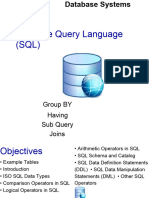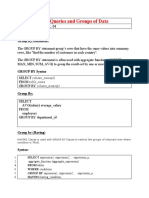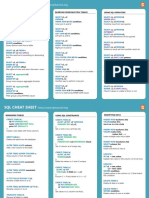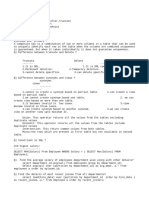0 ratings0% found this document useful (0 votes) 66 views4 pagesSQL Cheat Sheet
Comandos úteis em SQL por Steve Nouri.
Copyright
© © All Rights Reserved
We take content rights seriously. If you suspect this is your content,
claim it here.
Available Formats
Download as PDF or read online on Scribd
SQL Cheat Sheet
@— SQL Commands, Functions & Clauses
retrieves data (ron 0 database
ORDER BY = sorts the retedeved rows in specified order
vce) = returns the average value of a set of values
CUNTC) = returns the mimber of roms Sn a table or the imbue of nom-nl values
FIRST() = returns the First value Sn set of valves
STO) ~ returns the Last value in set of values
x() = cote the maximum valve Sn a sot of aloes
IN ~ seta the minim value Sn a sot of alles
SINC) = returns the sim of @ set of values
CONCAT() ~ concatenates tho or more strings together
INSTR() ~ returns the position of a substring within a string
LENGTH() = ceturns the Iength of a string
LoweRG)
LIRING) ~ removes leading spaces fron a string
converts a string to lowercase
REPLACE() - replaces oll occurrences of @ specified string with
ARIRIM() ~ removes ‘ailing spaces from a string
SUBSTR() ~ retuens @ portion of @ string
TRING) ~ removes leading and trailing spaces fron a string
UPPERG) ~ converts a string to uppercase
(CURDATE() ~ returns the curee
CURTINE() ~ returns the current tine
DATE() - extracts the date portion from a date/tine value
xTe900(),
DATEDIFF()
DOATEPART() - extracts a specified part of @ Jate/tine value
DAY() = returns the day of the month for a date value
POITHQ) = returns the month for a date value
ou{) ~ returns the current date and time
‘YEARG) ~ returns the year for @ date value
returns the difference beteen two dates
COALESCEQ) - returns the First non-null value in a List of values
TrMLLO
NULLIF() ~ returns ull 4€ two values are equal
returns @ specified value if @ value is null
INWER JOIN ~ returns rows that have matching values in both tables
OUTER 201N = returns rows that have matching values in either of the
tio tables
LEFT 0IN ~ returns all rows from the left table and any matching
rows from the right table
AIGAT 201M - returns oll rows from the right table and any matching
rows from the left t:
ble
FULL 30IN - returns all rows from both tables, whether or not there
fre matching volues
ross 201"
the first table being paired with each row from the second table
‘returns all rows from both tables, with each row from
UNION = combines the results of two or more SELECT statements,
climinating duplicates
UWTON ALL = combines the results of two or more SELECT statements,
including duplicates
INTERSECT ~ returns rows that ore present in the results of two or
more SELECT statements
[EXCEPT ~ returns nous that are present in the First SELECT statement
but not in the results of ony subsequent SELECT statements
SELECT - retrieves data fron a database within another SELECT
statenent
FRO - specifies which tables to retrieve data fron within the
subquery
WIERE ~ specifies which rows to retrieve based on certain conditions
‘within the subquery
(snoue BY - groups rows that have the same volucs in the specified
coluans within the subquery
HAVING - Filters groups based on o specified condition within the
subquery
INSERT INTO - adds @ new row to @ table
roar
DELETE ~ removes existing rows from a table
TRUNCATE TABLE - removes all rous from @ table
modifies existing data in a table
CREATE TABLE ~ creates @ new table
ALTER TABLE
DROP TABLE
TRUNCATE TABLE - removes all rows from a table
rodifies the structure of an existing table
deletes a table
CREATE INDEX - creates an index on a table to improve search
performance
Poncx By Steve Nouri
deletes an index fron a table�SELECT * FROM tabled ZI9E% 200% table? Ol tablet.cold = table2.col2
SELECT * FROM tabled waTURAL 3010 table2:
Outer Jom
SELECT * FROM tabled LEFT 201" table? OW tablet.colt = table2.col2
This type of join automatically matches rows
from both tables based on their common
columns. The common columns must have
the same name and data type in both tables.
Outer Jon
SELECT * FROH table RIGHT 201% table2 Ol tablet.colt = table2.col2
rms taba tt Tes ABpLY table vlund fncttonttctt) 12;
SELECT * FROW fablen FULL OUTER 20IN table? OW tablen.colL =
This type of join is similar to CROSS APPLY,
but it returns all rows from the left table,
even if there are no matching rows in the
right table.
Right Outer Join with Exclusion
S96 abled cold 15 MLS
‘Join with Exclusion
LEFT 2010 tablea ou tablen.cold = table2.col2
eRe taben.cold. 158
Full Out
Fuh OUTER 2008 tabled table. cold = tablen.cok2
Join
This type of join allows you to apply a table-
valued function to each row in a table and
join the results to the input rows.
Anti Semi Join
Foon tabler
HERE NOT EXISTS (SELECT 1 FROM table? WERE tabled.colt = table2.col2)
Semi Join ( Less duplication than Inner Join)
sevect *
om tables
[WERE OAISTS (SELECT 2 FROM Kable? WHERE tableL-colt = table2.col2);
Returns all rows from the left table that do not
have a match in the right table. Similar to a LEFT
JOIN, but it only returns the rows from the left
table that do not have a match in the right table,
Returns only the rows from the left table that
have a match in the right table. Similar to an
INNER JOIN, but it only returns the rows from
the left table that have a match in the right
table, rather than returning all rows from both.
Two Inner Joins,
sevect *
oH tablet rT0.eR 01H table? ON tablen.colt = table2.col?
LEFT 201N tablea 0 table2.col3 = table3.col4;
Two Left Outer Joins
SELECT *
FROM tablet LEFT 20TH table? OW table1.col1 = table2.col2
LEFT JOIN table3 oN table?.col3 = table3.col4;
This query will return rows from all three tables.
that have matching values in the joined columns.
Itwill first join tablet and table2 based on the
values in the colt and col2 columns
It returns all rows from the leftmost table, as
well as any matching rows from the other two
tables. Rows from the other two tables that do
not have a match in the leftmost table are NULL.�~- Sample data for the “enployees™ table:
44 | name | department | salary | hired on
a | Alice | #8 | 55000
2 | Bob | Marketing | 65000
3 | charite| 11 | 73000
4 [pave | sales | 0000 | 2670-04-01
Slee | me | 60000 | 2620-05-01
Sample data for the “sales” table:
aia | tage
zia | Gadger
312 | tage
a2 | Gadget
S12 '
eis '
714 | widget
aia | Gadget | 2021-01-01 | 000
oa | thinganajigl 2021-02-01 | 9800
wis [widget | 2021 | 20000
Sample data for the “products” table:
46 | product | price
2 | waget | 200
2 | odget | 200
3. | Thingasajigl 200
1- Retrieve all rows from the 'employees' table where the salary is greater than
155000.
SELECT * FROM employees HERE salary > 65000;
2-Retrieve the name and department of all rows from the ‘employees’ table,
sorted by salary in descending order.
SELECT name, department Fo! employees OROER BY salary ESCs
'3-Retrieve the product and total sales for each product in the ‘sales table,
sorted by total sales in descending order.
SELECT piproduct, SUM(s.sale amount) as total_sales io" sales 5
{TWMER 01% products p Oli S.product = p-product GROUP SY p.product
ORDER WY otal_sales ESC:
4-Retrieve the name and total sales forall employees inthe Marketing
{department from the ‘employees’ and 'sles' tables.
‘SELECT e.name, Sun(s.sale_amount) as total_sales 0% employees e
{WER DOIN sales 5 ON e.id = s.employee_id WiERE e.department =
“Marketing” GROUP BY e.name;
S5-Retrieve the name, product, and sale date forall sales inthe sales table where|
the sale amount is greater than 2500.
SELECT e.name, p.product, 5-sale_date £0! employees © IER J01N
Sales 5 0¥ e.fd = s.employee 4d Iivich 20IN products p On s.product =
product Wine 5.sale_oaount > 25
By Steve Nouri
‘Retrieve the name, product, and sale amount for all sales in the sales table that
‘occurred between June 1, 2020 and December 31, 2020.
SELECT e.mame, p.product, s.sale amount 0% employees @ rHvict 2008
sales 5 ON €.1d = s.employee_{d NER 201M products p Ol product =
Peproduct MIERE s.sale_date EETWEEN °2070-06-01" AND °2020-12-31°3
7-Retrieve the name, product, and sale amount for the sale with the highest sale
‘amount inthe sales table, along with the corresponding employee name from the
‘employees table.
SELECT e.mame, p.product, 5.sale_anount 0% employees «01% 200%
sales 5 ON eid = s.employee_id IWvic% 01M products p Olt s.product =
Peproduct WHERE s.sale_amount ri (SELECT MAK(sale_amount) FRO!
sales);
‘-Retrieve the name and manager ofall employees in the employees table,
‘showing the name of the manager from the employees table as well
SELECT el.nane 25 manager, e2.name 2: employee F70! employees et
{IWWER 2010 employees €2 0h et.id = e2.monager_{d;
‘Retrieve the name and number of employees forall managers in the employees
table who have atleast one employee.
SELECT e.name, (SELECT COUNT(*) FROM employees MERE manager_{d =
e-id) 25 mum employees Ao! employees € Wich: mum employees > ©;
10-Retrieve the name ofall employees in the employees table who do not have a
‘manager.
SELECT el.name, e2.name as manager (ch employees et LEFT 20181
‘employees €2 li e1.manager_id = e2-4d WHERE e2.name TS WILLS
1 -Retrieve the name and total sales forall employees in the employees table
who have made more than 5000 in sales in the past year (from the current date).
SELECT e.name, SUM(s.sale_amount) ss total_sales £0" employees ©
NWR 2000 sales 5 ON e-4d = s.employee id WERE s.sale date BETWEEN
WHERE
‘This order can be masified by the use of subqueries oF
GROUP BY | common table expressions (CTES), In these cases, the
subquey or CTE is executed fst and the results ae used in
HAVING | the auter query
SELECT
ORDER BY
Here is an example query to show the order of execution:
‘SELECT e.name, SiM(s.salle_amount) 2 total_sales
FAO employees ©
WER 201% sales = OW e.Sd = s.employee id
ERE e.department = ‘00 5.sale_date BETWEEN "2020-01-01" 10
sales
‘oRouP 8Y esmame
HAVING SUm(S.sale_emount) > 5008
‘ORDER BY total_sales DESC;
FROM and WHERE clauses are executed fst to select the relevant rows from the
‘emplayees and sales tables. These rows are then grouped by employee name and
aggregated using the SUM function in the GROUP BY clause. The HAVING clause
filters out any groups that do not meet the specified condition. Finally, the SELECT
clause selects the name and total sales for each group, and the ORDER BY clause
sorts the results by total sales in descending order.�@— Some Advanced Topics in SQL
1-Recursive queries: These are queries that can reference themselves in order
to perform a certain action, such as querying hierarchical data
WITH RECURSIVE cte_name AS (
SELECT se
warow (AL)
)
2.Window functions: These are functions that perform a calculation over a set of
rows, siilar to an aggregate function, but return a value for each row in the
result set.
SELECT colt, col2, function name(col3) OVER (PARTITION BY cold ORDER BY
col2) 2s cole
Ro table_nane;
3-Common table expressions (CTEs): These are named temporary result sets
‘that can be used within @ SELECT, INSERT, UPOATE, DELETE, or CREATE VIEW
statement. They are often used to simplify complex queries by breaking them up
into smaller, more manageable pieces,
En ete_name AS (
>
4-Pivt tables: These are tables that allow you to transform data from rows to
columns, or vice versa, in order to generate more meaningful insights from your
data
Fron (
SELECT colt, col2, col3
0 table_name
>
ror (
sm(eol3)
ot eol2 in (vala, val2, val3)
S5-Analytc functions: These are functions that perform a calculation over a
4aroup of rows and return a single value for each row inthe result set.
SELECT colt, col2, Function nane(col3) OVER (PARTITION BY colL ORDER BY
cold) as colt
70H table names
6-Triggers: These are pieces of code that ae automatically executed in
response to certain events, such as inserting, updating or deleting data ina
table.
‘CREATE TRIGGER trigger_name
AFTER 1NSERT OW table name
FOR EACH ROW
Stored procedures: These are pre-complled SQL statements that can be
stored in the database and executed repeatedly with different parameters.
[CREATE PROCEDURE procedure name (10 param datatype, 1! paran2
éatatype, --.)
GIN
(CALL procedure nane(parant_value, paran?_value,
B-Indexes: These are data structures that are used to improve the performance
of certain types of queries by allowing the database to quickly locate the desired
data,
‘CREATE: INDEX Andex.name OW table_nawe (C011, cOl2, ..
‘080? INDEX Snex_name;
9-Cursor-based processing: This isa method of processing data in which a
cursor is used to retrieve a small batch of rows from a result set, pracess the
rows, and then retrieve the next batch of rows until all ows have been
processed. This can be useful when working with large result sets or when the
processing needs to be done row by row.
FETCH MEXT FROM cursoR name INTO varfabled, vardable2,
arue gercroH_ staTUS = ©
FETCH NEXT FRCH CURSOR name INTO varsableL, vardable2,
BRT
























































